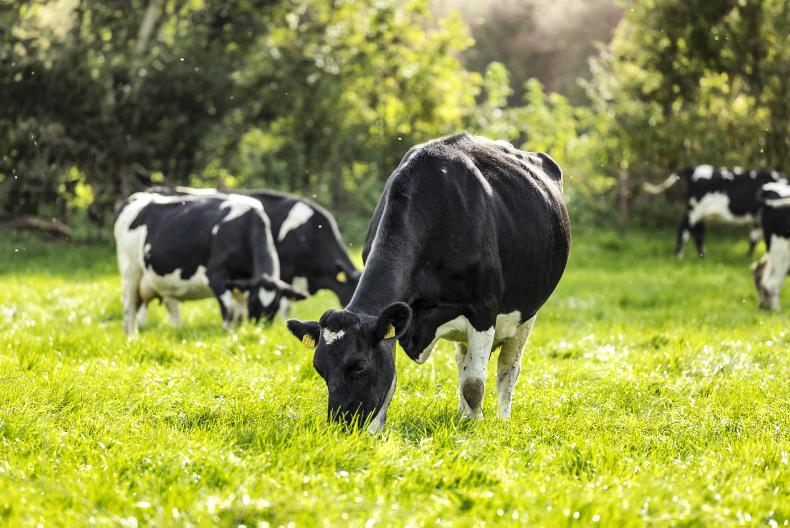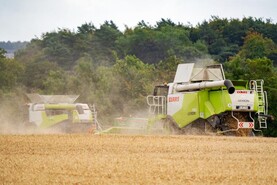Sulphur: A dry April can often lead to a sulphur deficiency in May and June, particularly on light or free-draining soils. Due to less sulphur in the atmosphere, sulphur deficiency is more of a concern now. After a very wet spring, more sulphur would have been leached than normal and with soils now dry there will be less mobility of sulphur within the soil. It’s hard to distinguish a sulphur deficiency from a nitrogen deficiency. In both cases growth will slow down and younger leaves will go yellow and look hungry.
Sulphur should be applied at a rate of 10% to nitrogen. So if you spread 180 units/acre of nitrogen in the year, then 18 units/acre of sulphur should be spread. Most will spread sulphur with nitrogen. If no sulphur has been spread to date and you are farming light soils, then a case could be made to go hard with a product like ASN (26 N, 14S) now. It just goes to show the importance of nutrients other than just nitrogen for grass growth. Phosphorus and potash are also critical. Potash is considered cheap irrigation in other countries, something to consider as some soils are getting dry.
Reseeding: A good turnaround time between spraying off and grazing a reseed is 60 days. This is often difficult to achieve if using minimum tillage techniques as it takes a long time for the old sward to die back. Cutting for silage as opposed to grazing will speed up the process as it will leave an even cleanout. Cultivating before the old sward dies back will lead to a lot of clods in the seed bed and somewhat uneven germination. However, numerous studies have found no real difference in the method of sowing on the subsequent field performance.
Regardless of technique used, timing is critical for a fast turnaround time. This is the best time of the year to get reseeding done as autumn reseeds are slower to germinate and grazing in late autumn and winter is trickier. Fields sprayed off today should be grazed again by the longest day of the year and will be performing very well by autumn.
COVID-19: Reports from some milk processors suggest some farmers are getting a bit lax around restrictions and precautions. Remember to keep your distance from lorry drivers and AI technicians and disinfect door handles and anything visitors into the farm are in contact with. While the spread of the disease may have slowed, now is not the time to relax social distancing on farms. The threat of infection on farms and within milk plants and AI stations still exists.
The effects of the pandemic were felt on most farms last week as milk price dropped. The milk price outlook for the year is now very uncertain. However, it’s worth remembering that in most years the margin doesn’t change. So when prices are good farmers spend more, and when prices are bad farmers spend less. Now is a good time to start looking at costs and deciding what can be cut. Whether or not to go ahead with planned capital expenditure depends on the financial situation. It can often be better to spend money in bad economic times as things generally cost less and good deals can be done. However, investments that were planned to be paid for out of cashflow should be reconsidered.
Read more
Dairy emissions drop by 3%
Will co-op structure save Irish milk price falls?
Sulphur: A dry April can often lead to a sulphur deficiency in May and June, particularly on light or free-draining soils. Due to less sulphur in the atmosphere, sulphur deficiency is more of a concern now. After a very wet spring, more sulphur would have been leached than normal and with soils now dry there will be less mobility of sulphur within the soil. It’s hard to distinguish a sulphur deficiency from a nitrogen deficiency. In both cases growth will slow down and younger leaves will go yellow and look hungry.
Sulphur should be applied at a rate of 10% to nitrogen. So if you spread 180 units/acre of nitrogen in the year, then 18 units/acre of sulphur should be spread. Most will spread sulphur with nitrogen. If no sulphur has been spread to date and you are farming light soils, then a case could be made to go hard with a product like ASN (26 N, 14S) now. It just goes to show the importance of nutrients other than just nitrogen for grass growth. Phosphorus and potash are also critical. Potash is considered cheap irrigation in other countries, something to consider as some soils are getting dry.
Reseeding: A good turnaround time between spraying off and grazing a reseed is 60 days. This is often difficult to achieve if using minimum tillage techniques as it takes a long time for the old sward to die back. Cutting for silage as opposed to grazing will speed up the process as it will leave an even cleanout. Cultivating before the old sward dies back will lead to a lot of clods in the seed bed and somewhat uneven germination. However, numerous studies have found no real difference in the method of sowing on the subsequent field performance.
Regardless of technique used, timing is critical for a fast turnaround time. This is the best time of the year to get reseeding done as autumn reseeds are slower to germinate and grazing in late autumn and winter is trickier. Fields sprayed off today should be grazed again by the longest day of the year and will be performing very well by autumn.
COVID-19: Reports from some milk processors suggest some farmers are getting a bit lax around restrictions and precautions. Remember to keep your distance from lorry drivers and AI technicians and disinfect door handles and anything visitors into the farm are in contact with. While the spread of the disease may have slowed, now is not the time to relax social distancing on farms. The threat of infection on farms and within milk plants and AI stations still exists.
The effects of the pandemic were felt on most farms last week as milk price dropped. The milk price outlook for the year is now very uncertain. However, it’s worth remembering that in most years the margin doesn’t change. So when prices are good farmers spend more, and when prices are bad farmers spend less. Now is a good time to start looking at costs and deciding what can be cut. Whether or not to go ahead with planned capital expenditure depends on the financial situation. It can often be better to spend money in bad economic times as things generally cost less and good deals can be done. However, investments that were planned to be paid for out of cashflow should be reconsidered.
Read more
Dairy emissions drop by 3%
Will co-op structure save Irish milk price falls?






 This is a subscriber-only article
This is a subscriber-only article










SHARING OPTIONS: